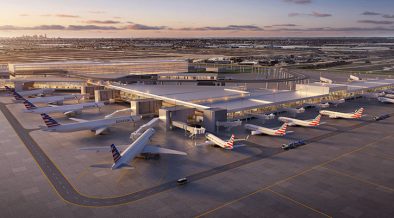
With traffic growth now firmly back on the agenda, airports across the globe are investing in new infrastructure to ensure that they are capable of meeting future demand, writes Joe Bates.
With ACI World predicting that global passenger numbers are expected to rise from to 9.5 billion in 2024 to 22.3 billion by 2053 – almost 2.4 times last year’s volumes – there can be no doubting that the aviation industry, and particularly airports, face a tough challenge to ensure that they are up to the job of accommodating the huge future increase in demand.
Aware of the challenges ahead, earlier this year ACI World revealed that to address the long-term growth in passenger demand, an estimated $2.4 trillion in total capital investment will be needed by 2040 for airport infrastructure.
These investments, it says, are essential to maintain a sustainable aviation ecosystem that maximises the social and economic benefits of air travel, including job creation and regional development.
On the following pages we highlight a number of global infrastructure development projects that are either on the drawing board, ongoing or have been successfully completed by airports seeking to ensure that they have the facilities and the capacity to meet demand and avoid becoming victims of their own success.
ACCELERATION OF TERMINAL F EXPANSION AT DFW
Dallas Fort Worth International Airport (DFW) and American Airlines have agreed to accelerate and expand the scope of the gateway’s new Terminal F by doubling the number of gates, adding facilities to grow international operations, expanding customer amenities, creating a single building for passenger check-in and more.
The new plan extends the Use and Lease Agreement between DFW and American to 2043 and increases the estimated Terminal F investment to about $4 billion to create what will be DFW’s signature terminal experience, serviced entirely by American.
In 2023, DFW and American Airlines reached a new 10-year Use and Lease Agreement with pre-approved capital investments, including the construction of Terminal F as a 15-gate facility which passengers would access from Terminal E via the airport’s Skylink system. Future plans included the addition of dedicated areas for ticketing, check-in, security screening, baggage claim and parking facilities.
However, due to the positive long-term outlook for growth at DFW and the North Texas region, the Terminal F expansion programme will now include all the previously planned phases ahead of schedule. This consequential investment will expand the scope of Terminal F to deliver additional capacity for widebody aircraft and international flight processing and includes additional spaces for state-of-the-art amenities, more shops and restaurants, and public art.
In addition to a new centralised Skylink Station, the new Terminal F will also provide a walking connection with Terminal D, creating even more access across DFW’s terminals.
Plus, the new parking garage is set to be one of the airport’s largest with a design that includes built-in kerbside circulation to maintain the quick access to check-in and security that DFW passengers have come to expect.


The original first phase of Terminal F is well underway and still scheduled to be operational in 2027, with the newly added phases planned to come online in additional phases.
American plans to occupy all 31 gates of the new terminal, creating even greater operational efficiencies for the airline and an enhanced experience for connecting passengers – which make up about 60% of DFW’s passenger traffic.
“In the last decade, DFW has grown its passenger traffic by 50% and exceeded the wildest expectations of our founders to become the third-busiest airport in the world,” enthused airport CEO, Sean Donohue.
“Thanks to our close partnership with Robert Isom, American Airlines remains a competitive advantage that continues to show the strength of the airport as a global hub that is supporting the massive economic growth of the Dallas Fort Worth region. Moving forward with Terminal F in this way ensures that DFW and American maintain that momentum.”
With the new vision for Terminal F, the airport’s ongoing DFW Forward capital plan became even more historic with a total of more than $12 billion in transformational investments, either planned or underway, that will provide major improvements and expansions across the airport’s extensive facilities and complex infrastructure over the next several years.
This includes the approximately $3 billion programme underway to completely reimagine and expand Terminal C, as well as expand Terminal A.
SINGAPORE CHANGI’S MEGA TERMINAL
A significant step in the development of Changi Airport took place on May 14 when Singapore’s Prime Minister Lawrence Wong officiated at the groundbreaking ceremony for the gateway’s Terminal 5.
Airport operator Changi Airport Group (CAG) describes Terminal 5 as a ‘mega terminal’ that will strengthen the airport’s position as a leading air hub.
According to Changi Airport Group (CAG), T5 will be powered by state-of-the-art airport systems and extensive automation that will allow the airport to significantly increase its handling capacity, optimise operations and leverage new opportunities as travel demand continues to increase in the decades ahead.
Although linked to the existing terminals at Changi Airport, CAG notes that Terminal 5 can operate as a single integrated air hub.
It is designed to handle about 50 million passengers annually in its first phase which is expected to open in the mid-2030s.
With Asia-Pacific projected to be among the fastest growing air travel markets over the next two decades, CAG says the additional capacity at T5 will enable Singapore to ride on the long-term growth of aviation in the region and beyond.
For the first time, T5 will see Changi Airport house a ground transportation centre, bringing together train, bus, taxi and other transport services.
This, says CAG, will enhance Changi’s connectivity to the rest of Singapore, making the airport accessible not just for travel, but also as a destination for “local residents to enjoy”.
Plans are in progress to extend both the Thomson-East Coast Line and the Cross Island Line to T5, to connect it to the city centre and other major hubs.
Terminal 5 also offers the possibility of enhanced air and sea connectivity – for more seamless passenger travel, including convenient connections to neighbouring destinations via ferry services.
In addition, T5 will be a Green Mark Platinum Super Low Energy building, which is more energy efficient. It will be powered by more clean energy to reduce the carbon footprint of Changi Airport and be equipped with building management systems that feature innovative and efficient systems design.


If all goes to plan, the terminal’s rooftop solar system will be one of the largest in Singapore, potentially generating enough energy to power about 20,000 4-room HDB flats for a year.
Inspired by Singapore’s unique blend of nature and city, T5’s design concept is said to be characterised by a unique collection of overlapping curved roofs with varying heights.
According to CAG, the ‘roof leaves’ break the mega terminal building into smaller spaces that are more human scale. Combined with natural light and landscaping at appropriate spaces, it says that the terminal will have the familiar cosy, yet uplifting, feel that Changi is known for.
CAG CEO, Yam Kum Weng, said: “Our vision is for T5 to be mega yet cosy, a terminal that embraces the Changi DNA – delivering a personalised, stress free and positively surprising airport experience.
“As a new gateway to Singapore, T5 offers new possibilities and will bring new surprises. It will offer yet another vibrant space for families, friends and the airport community to gather and bond.”
VILNIUS AIRPORT’S NEW ARRIVALS TERMINAL
Zaha Hadid Architects (ZHA) has won the international architectural competition to design the new Arrivals Terminal at Vilnius Airport.
The project represents a significant milestone in the airport’s long-term strategic plan to accommodate predicted growth in passenger demand and strengthen Lithuania’s position as a leading gateway in the Baltic region.
As outlined in the last issue of Airport World, Lithuanian Airports is developing the new Arrivals Terminal at Vilnius Airport as a strategically important project for the country’s aviation and economic growth. Supporting the recent completion of the airport’s Departure Terminal, the new facility (pictured above), will enable the airport to serve up to 10.6 million passengers annually.
“For us, functionality and the highest level of passenger experience are most important. The winning proposal combines these key requirements with unique architectural solutions that connect the airport’s contemporary and future infrastructure with the cultural identity of Lithuania,” enthuses Simonas Bartkus, CEO of Lithuanian Airports.


“We consider the terminal to be an excellent business card for all visitors.”
ZHA reveals that its design draws from Lithuanian cultural heritage, incorporating traditional motifs and art forms within a contemporary architectural language. The terminal’s modular geometry , it explains, originates from the rhombus, a triangular shape that holds significant meaning in Baltic folklore.
“The design presents a mature architectural solution for a public infrastructure project of this scale. It boldly steps into the future but maintains respect for its location and the environment,” notes Laura Kairienė, chief architect of Vilnius City Municipality
“I believe the new terminal will not only ensure functionality and passenger comfort, but will also become an example of sustainable, high-quality architectural development in Vilnius.”
MUNICH AIRPORT’S NEW TERMINAL 1 PIER
Munich Airport has confirmed that the expansion of its Terminal 1 pier is progressing smoothly and on target for completion next year.
Described as “Bavaria’s new business card for passengers”, the €665 million expansion to the pier will effectively create a state-of-the-art terminal for non-Schengen traffic.
Its capacity of up to six million passengers per year is roughly equivalent to the total passenger volumes of an airport like Hanover in Lower Saxony.
“It is impressive to see how the Terminal 1 concourse is gradually taking shape,” notes Munich Airport CEO, Jost Lammers.
“You can now easily imagine how passengers will arrive and depart here in less than a year’s time. We are not only creating additional capacity, but also a new level of quality and comfort for our passengers.”
At around 360 metres long and 95,000 square metres in size, the terminal extension will allow for the simultaneous handling of up to twelve smaller aircraft or six wide-body aircraft.


Passengers flying with American Airlines, Delta Airlines, Emirates, Etihad Airways or Qatar Airways can look forward to a new centralised security checkpoint featuring the latest CT technology, spacious waiting areas and an array of retail and F&B outlets as well as relaxation zones.
After a trial period in the coming months, the new terminal pier will officially open in the first half of 2026.
LIMA’S NEW TERMINAL A MILESTONE FOR SOUTH AMERICA
Lima Airport Partners (LAP) is celebrating the official opening of the new terminal at Lima’s Jorge Chávez International Airport (LIM) in the Peruvian capital.
When fully open at the end of 2025 it will cover 270,000 square metres, ensuring that it is three times the size of its predecessor and capable of handling up to 40 million passengers annually.
According to LAP, thanks to its modular design, the terminal’s capacity can be increased to accommodate future growth.
Fraport CEO, Dr Stefan Schulte, says: “The opening of the terminal is a milestone – not just for Fraport, but also for Peru and South America.
“Our goal is to make Lima one of the continent’s most important hubs, providing a boost to tourism, air cargo traffic and connectivity for all Peruvians.
“The opening of this flagship project clearly symbolises our commitment to Peru. We’ve worked together with our Lima Airport subsidiary and our partners to build the new terminal and the first Airport City in South America, connecting air travel with cargo, logistics, retail, and hotels.”
The approximately $2 billion expansion programme that began in 2019 involved building both the terminal itself and related infrastructure. Key elements of the project included a second runway, a new air traffic control tower, aircraft parking positions, energy supply facilities, transportation connections, and parking facilities for passengers and visitors.
Fraport notes that new terminal features future-proofed technologies, including CT scanners at security checkpoints, while at the same time reflecting Peru’s history and culture. Works created in partnership with local Peruvian artists are located throughout the terminal, representing the country’s three regions – the coast, the rainforest, and the mountains.
In addition, restaurants across more than 8,000 square metres of floorspace provide ample opportunity for travellers to savour Peruvian cuisine.
Lima Airport Partners CEO José Salmon says: “The new terminal is the heartbeat of Peru. This airport will create approximately 120,000 jobs, benefiting our neighbouring communities.
“Furthermore, the airport will contribute to our country’s economic growth, creating jobs for future generations, boosting business, and promoting the recovery of tourism.”
CHONGQING JIANGBEI OPENS GIANT NEW TERMINAL
Chongqing Jiangbei International Airport unveiled its new T3B terminal in April, marking a significant milestone in its ambitious expansion programme.
The new addition means that the southwest China located gateway now has three terminals, one satellite hall, four runways and cargo facilities capable of handling up to 80 million passengers, 1.2 million tonnes of cargo and 580,000 aircraft movements annually.


T3B is said to boast advanced smart features and intelligent technology that have transformed traditional passenger processing procedures at the airport.
As a result of its opening, the airport notes that 151 of its 222 boarding gates now utilise facial recognition self-service technology capable of processing passengers in as little as five seconds.
Autonomous trains will link the 360,000 square metre T3B with Chongqing Jiangbei International Airport’s other terminals.
Adding to the terminal’s futuristic appeal are 22 multifunctional “compass box” robots that integrate flight information display, broadcasting, surveillance, and fire safety functions.
Chongqing Jiangbei currently handles around 200 international flights per week, connecting the gateway to North America, Europe, Oceania, the Middle East, Japan, Korea, and Southeast Asia.
LONG THANH SET TO OPEN IN LATE 2026
The first phase of Vietnam’s new $4.6 billion gateway, Long Thanh International Airport, is on target to open in late 2026, according to local news reports.
Vietnam’s Minister of Construction, Tran Hong Minh, recently visited the airport site when Le Quyet Tien, Director of the Department of Economics-Construction Investment Management at the Ministry of Construction, revealed that the construction of several key projects is being accelerated.
These include the construction of the terminal’s roof, second runway, 115-metre-tall air traffic control tower, aircraft catering facilities roadways, bridges and maintenance hangars.
Long Thanh’s main 4,000-metre-long runway, Runway 1, was completed on April 26, 2025, three months ahead of schedule and, according to reports, the lighting system has been successfully tested and is ready for calibration flights.
Concluding the meeting, Minister Tran Hong Minh stated that people of Vietnam have placed a lot of trust and hope in the Long Thanh airport project because it is a large project being built by Vietnam for Vietnam.
The country’s much-awaited new international airport is being built in Long Thành, Dong Nai Province, around 40 kilometres east of Ho Chi Minh City.
ANEMOS CONSORTIUM TO DESIGN THE EXPANSION OF ATHENS INTERNATIONAL AIRPORT
The Anemos consortium consisting of Arup, Grimshaw, Haptic, Athens-based K-Studio, Leslie Jones, Plan A and Triagonal A has been appointed to design the expansion of Athens International Airport (AIA).
The project will increase the capacity of the airport from 26 to 40 million passengers per annum by 2032 through a phased programme delivered within a live operational airport environment.
The expansion will include extensions and alterations to the main and satellite terminal buildings of the current airport as well as landside and airside updates, aircraft stands, gate seating and commercial areas, all delivered through a phased programme while the current airport remains operational. The strategy for delivery across the terminal buildings aims to modify and extend while minimising disruption to the existing facilities.
The concept design is integrated with sustainability at its heart with five clear overarching principles centred around achieving operational net zero, enabling climate resilience, protecting the natural environment, achieving resource efficiency and providing wellbeing for passengers and staff.


Conor Hoey, Arup’s aviation business leader for Europe, says: “The Anemos team was brought together by its shared values, approach and purpose and combines deep local knowledge and international expertise in the design and delivery of complex infrastructure and aviation projects.
“As world leaders in aviation design, Arup is proud to bring its advanced approach – integrating energy, digital technologies, sustainability and user-centred design – to the team.
“This win is a testament to the AIA’s trust in us to support it in reaching its full capacity with a fresh, innovative and passenger-focused experience that will exceed the highest standards of aviation excellence.”
Originally designed and constructed by Hochtief and completed in 2001 ready for the Athens 2004 Summer Olympics, Athens International Airport is the largest airport in Greece, located 20 kilometres from the city centre.
NEW ARRIVALS AREA IN QUITO
Quito’s Mariscal Sucre International Airport has unveiled its new and improved International Arrivals area as part of a $74.2 million upgrade. The newly opened area is 3,500 square metres bigger than before providing much needed extra space that operator, Corporación Quiport, says allowed it to “optimise the arrival process for international passengers”.
In effect this means that the customs area, X-ray screening, and public arrival hall have been expanded to make the entry process more comfortable, faster, and more efficient.
The overall expansion project is now 65% complete and on track for completion in December this year.
In addition to the new Arrivals area, the upgrade has already added a new boarding bridge and an extra 35,000sqm of apron for parking aircraft up to the size of the B777, B787 and A330.
The airport notes that “advanced electrical systems” have been installed, including a main generator, over 3,000 metres of fibre optics, and 16 communication rooms.
A new baggage handling system and technical systems such as HVAC and fire protection networks are said to be progressing rapidly ahead of the October opening of a new Departures Hall with 20 check-in desks for international airlines and a new 1,800sqm boarding lounge.
Quiport believes that the investment in new facilities reaffirms its commitment to the development of Quito Airport, ultimately “offering greater capacity, improved services and more spacious areas for passengers”.
Ramón Miró, president and CEO of Quiport, said: “This expansion is not just an investment in infrastructure – it is a commitment to the future of Ecuador’s connectivity.
“We want every passenger arriving or departing from the country to enjoy a smooth, comfortable, and safe experience, and to leave with a good impression.”


WORLD EXPO VISITORS ENJOY KIX’S NEW-LOOK T1
Kansai International Airport’s fully refurbished Terminal 1 opened as planned a few weeks ahead of the World Expo in Osaka which is expected to attract millions of extra visitors to the region this year.
The upgrade to the iconic terminal building has led a 60% increase in the size of the international departure lounge and retail offerings, the introduction of innovative retail layouts based on passenger experiences, and the creation of a seamless processing experience.
Kansai Airports and global design firm Populous have been working for more than seven years to completely reimagine the airport’s floor plan, bringing a new level of efficiency and experience for travellers to western Japan.
Populous led the architecture and interior design of the redevelopment, as well overseeing the project throughout construction.
The project was completed in four phases to allow for continued operations of the airport, which is expected to accommodate more than 40 million passengers a year from 2025 and almost double its international capacity.
The final phase of the project was completed in late March 2025, to allow for the consolidation and extension of the security screening area ahead of World Expo 2025, which began in April in Osaka.
A new commercial area in Terminal 1 includes 13 stores across international departures, international arrivals and a street food court.
Regarded as part of the high-tech architecture movement of the 1990s, KIX’s industrial design is famous for its asymmetrical clear span sweeping aerofoil roofline.
At 1.7 kilometres long, it is one of the longest airport passenger terminal buildings in the world.
BECHTEL TO HELP DELIVER RIYADH’S KING SALMAN INTERNATIONAL AIRPORT
Bechtel has signed an agreement with the King Salman International Airport Development Company to serve as the delivery partner for three new terminals at King Salman International Airport (KSIA) in Riyadh.
Signed during US President Donald Trump’s visit to Saudi Arabia, the agreement highlights growing US-Saudi infrastructure ties and builds on Bechtel’s experience in delivering more than 300 projects in Saudi Arabia, including the recently opened Riyadh Metro.
The airport, expected to be one of the world’s largest when it opens in the coming decade, is a key pillar of Saudi Arabia’s Vision 2030.
“The King Salman International Airport is a landmark project that will reshape Riyadh and enhance the lives and communities it serves,” said Darren Mort, president of Bechtel’s infrastructure business.
“We have delivered some of the world’s largest and most complex airports, incorporating innovative and sustainable solutions and look forward to partnering with the King Salman International Airport Development Company to bring their vision of a world-class passenger experience to life.”
When fully completed, King Salmon International Airport is expected to boast six parallel runways and be capable of handling up to 185 million passengers and 3.5 million tons of cargo annually by 2050.
Bechtel will work with the King Salman International Airport Development Company to manage delivery of a terminal for commercial carriers, Terminal 6 for low-cost carriers, and a new private aviation terminal with hangars.


The project team will prioritise achieving LEED Platinum certification by integrating innovative sustainable practices into the design and construction of all three terminals.
The terminals will absorb or replace all existing facilities at Riyadh’s current gateway, King Khalid International Airport.
BANGKOK SUVARNABHUMI EXPANSION
Airports of Thailand (AoT) has confirmed the ambition to upgrade Bangkok-Suvarnabhumi Airport (BKK) to equip it to handle up to 150 million passengers per annum by 2033.
AoT’s $4.3 billion master plan for BKK, which currently accommodates around 60mppa, includes the eastern expansion of the existing terminal, the construction of a U-shaped South Terminal, addition of a fourth runway and a new Automated People Mover (APM) system to link the new terminal with the main passenger terminal.
AoT notes that the $365 million East Expansion project for the main terminal will raise BKK’s design capacity by 15mppa to 80 million. Construction is scheduled to begin in November, with completion expected by 2028. The expansion will increase the terminal’s footprint to 480,000 square metres.
The huge new South Terminal is expected to feature around two kilometres of kerbside and be capable of handling 70mppa on its own when it opens 2033.
At its heart will be a 200,000-square-metre ‘Mega Terminal’ boasting commercial areas, shopping, and dining facilities accessible to both travellers and the public.
Earlier this year, Thailand’s King Maha Vajiralongkorn Phra Vajiraklaochaoyuhua and Queen Suthida Bajrasudhabimalalakshana officially inaugurated BKK’s new Midfield Satellite building (SAT-1) and third runway.
NEW OMANI AIRPORT
The Sultanate of Oman is set get a new $250 million gateway to replace the capacity constrained Khasab Airport located in an Omani enclave on the Musandam Peninsula.
With the design process for the planned new Musandam Airport now complete, Oman’s Civil Aviation Authority is inviting bids from consultancy companies to carry out a value engineering study for the gateway, which is slated to open in the second half of 2028.
According to reports, Musandam Airport will be developed in two phases, initially boasting a 250,000 passengers per annum capacity terminal and a single 2,500m metre long runway runway capable of handling aircraft up to the size of the B737 and A320.
A proposed second phase will see the runway lengthened to 3,300 metres, with the ability to handle widebody aircraft, an expansion of the terminal building, more taxiways, and enlarged apron areas.
The new airport is one of several scheduled to be built, or expanded, under plans by the Sultanate to improve its aviation infrastructure.
The Musandam Peninsula, overlooking the strategic Straits of Hormuz at the mouth of the Arabian Gulf, is an Omani exclave, separated from the rest of Oman by UAE territory.
The enclave’s current gateway, Khasab Airport, has operational constraints that include the inability to operate on a 24-hour basis.






